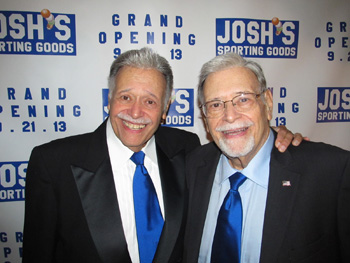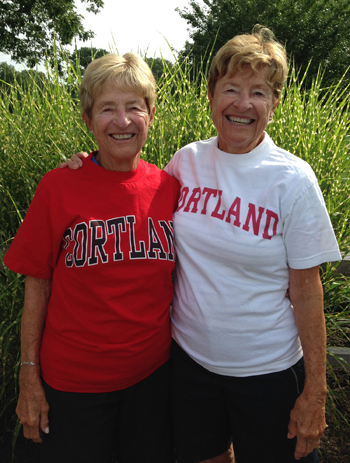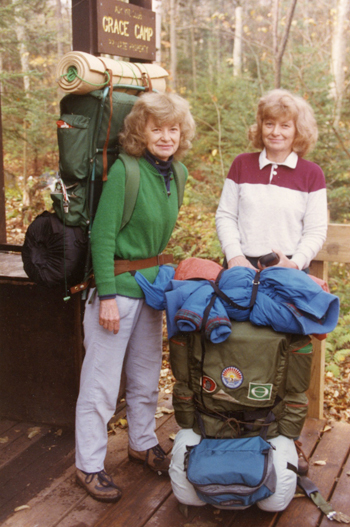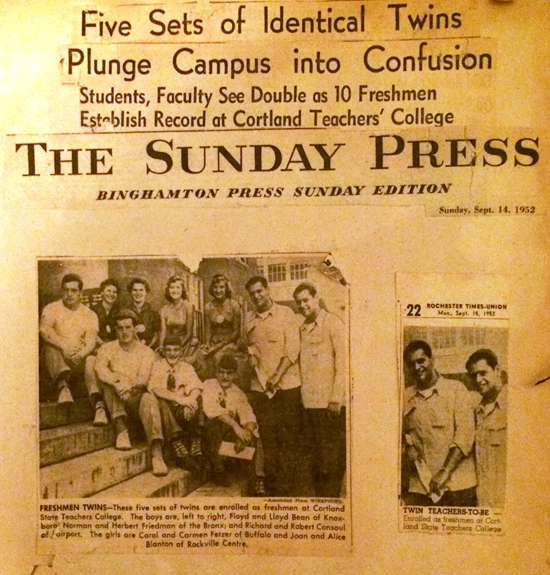News Detail
08/13/2014

In September 1952, the nation’s eyes briefly saw double on the New York State Teacher’s College at Cortland campus.
For about one week, the national press descended upon the tiny College to interview and snap pictures of the bumper crop of identical twin freshmen as these men and women began the pursuit of a college education.
“It was rather a surprise when we got on campus to find out that there were so many other twins,” recalled one twin, Herbert Friedman ’56. “We got followed around and lots of photos were taken of us. There was a picture of us in the (New York) Times.”
This year as some of those twins turn 80, all that remains are faded newspaper clippings and faint memories of at least five sets of mirror image students who arrived on campus from diverse locales around New York state: the Beans from Knoxboro, the Blantons from Rockville Centre, the Consauls from Fairport, the Fetzers from Buffalo and the Friedmans from Bronx.
Herbert and his brother, Norman Friedman ’56, recalled the events that unfolded in the then much smaller and very close-knit Cortland campus community.
“When the College realized there were so many sets of twins they knew they could get all the publicity in the world,” Norm said.
At the opening academic convocation, Dean of Students Albert Baisler requested that all the groups stand up to be seen, Friedman said.
 |
|
Herbert Friedman ’56, left, and Norman Friedman ’56 recently celebrated their 80th birthdays.
|
“We were asked to retire to the back of the room, and I think there were reporters from all over the United States,” Norm said. “It was sort of a national story. It was exciting for all of us.”
One very memorable group photograph included five pairs of matched siblings wearing freshman beanies. The image was picked up by the Associated Press and appeared in newspapers across the country. Unfortunately, the caption mixed the diminutive and bespectacled Bean brothers — Floyd and Lloyd — of Knoxboro, Oneida County, with the hulking Friedmans.
“Everyone who knew us from the Bronx thought it was hysterical that we were called Floyd and Lloyd Bean,” Herb said.
For about a week that first September, the news media followed the many look-alike siblings around Cortland, Norm recalled.
“They came to our classes and homes,” he said. “They wanted to take our measurement for blazers and trousers and on Sunday, they wanted us to wear the clothes they made for us and meet the townsfolk. My brother and I reacted to that as if it were a freak show.”
So the brothers made good use of their newfound campus celebrity status to approach then-President Donnal V. Smith with a request to quash the scheme.
“And he agreed and stopped it,” Norm said. “He realized we all had to lead our lives and not be people we were not meant to be.
“We needed to stop this and the College permitted it to happen.”
Four Years of Multiple Siblings
The Tinkham sisters arrived at Cortland in 1953, well after the furor had faded. Yet former classmates reminisce about them among the many identical brothers and sisters roaming the campus.
Commuting from nearby Scott, the Tinkhams both entered college at 17 and took summer classes together in addition to the regular semester’s offerings.
“My sister and I accelerated our education, starting out with one class and ending up in a class ahead of us,” explained Mary Tinkham Putnam ’56. “So we never really got to know many students except the ones who accelerated with us.”
“When we graduated from high school, our GPA was 1/10th of 1 percent different from each others’,” said her sister, Margaret Tinkham Watrous ’56. “In college, we got the same marks so our GPA was the same all through college.”
Mary and Margaret completed their student teaching in Moravia together. Their youthful looks were more remarked on than their lookalike status.
“I knew a senior there who had transferred from the Homer district, where I had gone to school,” Mary Putnam said. “But I wasn’t supposed to speak with him because I was considered to be a teacher.”
Martin Greene ’56, who is not a twin, vaguely recalls the early hoopla. Yet the pair he got to know the best soon left school, probably to join the military.
“Lloyd and Floyd (Bean) put up signs at the room they shared together in Cheney or DeGroat Hall that they would iron and launder shirts for 15 cents per shirt,” Greene said. “They took a lot of teasing about it. Tuition was free so it was probably to help them pay for room and board.”
The fun-loving Blanton sisters from Rockville Centre couldn’t fool any of their friends over who was who, but nevertheless tried a few pranks including switching places in class.
“It always backfired because the teachers seemed to know us apart,” said Alice Blanton Vogel ’56.
 |
|
Joan Blanton Cummings ’56, left, and Alice Blanton Vogel ’56 recently vacationed nearby each other in North Carolina with their families. |
“One time Alice and I had blind dates with men in Cortland,” recalled Joan Blanton Cummings ’56. “It was very formal, as they gave us each a corsage. They picked us up at the (Alpha Sigma) sorority and took us to a dance downtown. Alice and I switched our corsages, only to amuse our friends. The boys didn’t know us anyway but all our friends were hysterical. We told the men when we got home. They were mad; they didn’t think it was even a bit funny.”
The limelight fostered no special friendships between the different sets of twins.
“We didn’t have very much in common,” Herb Friedman said. “We found friends in other places.”
Alice Vogel remembers that she and Joan felt closer to the 11 Cortland classmates who hailed from their high school in Rockville Centre.
“My whole experience at Cortland was so fond and wonderful,” she said. “I was very comfortable there. There was always an old friend there.”
Sticking together everywhere seemed just ordinary to the various twins.
The Blantons joined Alpha Sigma sorority, rooming at the house and sitting side by side in classes for the same major.
Both the Friedmans worked summer jobs together at a treatment center for emotionally troubled children located not far from their hometown, Norm said. Later, they were perhaps the first Cortland Teacher’s College students to complete their student teaching in elementary education at a location remote from campus, Hawthorne Cedar Knolls, a public special act school district for children with special needs. At first they were denied the chance to gain the experience so far from the campus. They once again approached President Smith, convincing him this time to change the school’s policy on student teaching supervision.
Norm and Herb both joined the Hilltop Masquers, Herb striding the boards while Norm mainly toiled backstage.
“It worked out that way and both of us were happy doing it,” Norm said.
They once appeared onstage together in a production of “Liliom.”
“We were made up to look different,” Norm said. “I played the part of a judge with a great white beard and balding head while Herb played a role that was more like himself. But lots of people knew we were twins.”
Norm and Herb don’t recall any tales of high-spirited pranks or identity mix-ups involving any of the twins.
“The other thing in Herb’s life and mine that was very significant was that we never got into any kind of trouble,” Norm said. “If Herb saw me doing something I shouldn’t, he would warn me, and I would do the same for him.”
Norm attributes this closeness with Herb to being a twin.
“It’s a very unique experience that no one else shares,” he said. “We started out as womb-mates and, growing up as a twin, you never have to look for anybody else to play with.”
The Twins Then and Now
Barely 20 years old, Mary and Margaret Tinkham walked at the 1956 Commencement.
“We were asked to vote at that time and we weren’t old enough then,” Mary Putnam said. “We both got jobs in the Balston Spa district and taught there for three years.
“At Ballston Spa, the first time (Margaret) went into the staff room they kicked her out because they thought she was a student,” Putnam said.
“Sometimes we would switch classes with each other, just on special occasions like April Fools’ Day,” Putnam said. “The kids got a kick out of that.”
“At the start of school I always had to ask the students if they were in the right classroom, because Mary taught second grade and I taught third,” her sister, Watrous, noted.
 |
After retirement, Mary Tinkham Putnam ’56, left, and Margaret Tinkham Watrous ’56, took up hiking and backpacking, as shown in this undated Adirondack Mountain trip photo.
|
“It was kind of time to split up,” she said. “What I realized when I started teaching at a different school from Mary was that no one had ever called me by my first name before,” Watrous said. “They were afraid they wouldn’t be able to tell us apart. Then I was assigned a set of identical twins in my class and I had the same problem.”
For the balance of their careers, the two sisters were separated by jobs in districts two hours apart by car, as well as by marriage and raising families — two girls and three boys for Mary and Margaret respectively. Mary worked in Ilion, near Herkimer, and Margaret in Chenango Forks near Binghamton. Long hours on the telephone reconnected them.
"There was a little girl, a first grader in my school, who was moving to my sister’s district for the second grade,” Putnam said. “She was scared to death. I asked her to call my sister. The girl went there and found my sister and she was as happy as a lark. In fact, she would call my sister by my name all the time.”
At 55 and in early retirement, Mary and Margaret hit the hiking trails together, completing upstate New York’s Finger Lakes Trail system, bagging the 46 highest peaks in the Adirondacks, and, between 1998 and 2003, proceeding piecemeal from Maine to Georgia, completing the entire Appalachian Trail.
They travel together to places like Lower Michigan and Plymouth, Mass., to study family genealogy. They even have attended the Twinsburg Festival in Twinsburg, a small community between Dayton and Cleveland, Ohio, where some 2,700 registered identical twins have gathered and celebrated their uniqueness annually for decades.
“Frequently we find that we do the same thing at the same time without talking about it first,” Mary said. “We don’t buy the same clothes but we trade clothes with each other. We still weigh the same.”
“Did Norm tell you we almost had a Broadway career together?” Herb asked.
As campus president of the dramatic honor society Delta Psi Omega, Herb had made a Broadway contact named Donald Sommers while organizing a week of one-act National Theatrical Association productions. Norm, meanwhile, promoted Sommers on WKRT radio for a campus speaking engagement. That professional insider remembered the “twins from Cortland” who were “OK at acting” when roles for two Irish cops materialized in the Big Apple.
“After we had graduated and were working, my mother got a call from a Broadway producer looking everywhere for the Friedman twins,” Herb said.
They were invited to read for a part on Broadway with English actor Roddy McDowell and the American character actors Keenan Wynn and Paul Ford.
“Norm and I read; and we got the part,” Herb said. “But what happened was we were both teaching in different schools when we could have gone into the Army. We had instead got deferred. We were told ‘Your military board can release you, but it won’t if you stop teaching.’”
The rest is history for these twins, who continued as educators for their entire careers working about a stone’s throw away from one another.
Both married and raised families. Herb retired as superintendent of schools at Hawthorne Cedar Knolls in Westchester County, the place of his student teaching days. Norm, who retired as director of the Hawthorne Cedar Knolls Residential Treatment Center, now teaches child abuse prevention workshops — particularly to those involved in summer camp. He has a published book, Inoculating Your Children Against Sexual Abuse: What Every Parent Should Know!
“I’m grateful for what I got from Cortland that made me be able to do the work I’ve done,” Norm said. “To see the commitment on the part of my many instructors who were not only teaching but were people who inspired us. They were men and women who had spent years at Cortland or other institutions with a focus on educating us — not necessarily in subject matter as their primary focus — to understand the responsibility that we had in working with other people’s children. That helped me focus on what I needed to spend my life doing.”
Herb would second that opinion.
As for the former Blanton sisters, after graduation the young Long Island schoolteachers teased their students every April fool’s day — for the first few years — by swapping their third grade and elementary classrooms.
They married good friends and College graduates. Alice wedded Walter Vogel ’55. Joan tied the knot with Wade Cummings ’56, who is now deceased. The pair lived in adjacent towns for years and both taught in the Centereach district for 27 years.
This summer, they continue a more recent tradition of taking adjacent rentals together on the Outer Banks of North Carolina, with each beach house containing their by now very large families. Joan and Alice bore eight sons between them. And the youngest of Joan Cummings’ five sons are fraternal twins.
“They are like brothers,” Cummings said of the cousins raised almost as siblings.
“We live close together and everyone tells us we look more alike than ever,” Cummings said of her sister.
“I seem to really and truly need her,” she said.
 |
|
The Friedmans shared these scrapbook newspaper clippings about the brief time on campus in 1952 when five sets of twins created a media uproar.
|

